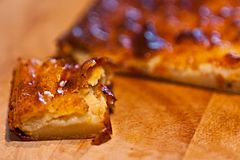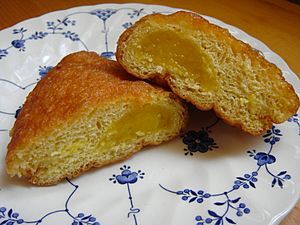Gibraltarian cuisine facts for kids
Gibraltarian cuisine is a special mix of foods from different cultures. It shows the long history between the people of Andalusia in Spain and those from Great Britain. Many people from other countries have also made Gibraltar their home over the last 300 years.
These influences include cooking traditions from Malta, Genoa (in Italy), and Portugal. This blend of tastes has created a unique mix of Mediterranean and British cuisine in Gibraltar.
Here are some examples of popular Gibraltarian dishes.
Contents
Pasta Dishes
Rosto
Rosto is a popular local pasta dish that comes from Italy. It uses penne pasta mixed with a tasty tomato sauce. The sauce usually has beef, or sometimes pork, along with mushrooms and carrots. Some families add other vegetables too. It's topped with grated "queso bola" cheese. The name "Rosto" likely comes from the English word "roast."
Fideos al horno
This is a baked pasta dish, very similar to dishes found in Spain, Malta, and Greece. It's made with macaroni pasta and a rich bolognese sauce. Other ingredients like egg and bacon can be added, depending on family recipes. The macaroni is usually covered with a layer of grated cheese or béchamel sauce. This melts during baking and helps hold the dish together. Even though it uses macaroni, the name fideos al horno means 'baked noodles' in Spanish.
Bread Dishes

Savoury Breads
Calentita
Calentita is a baked dish that looks like a thick pancake. It's similar to the Italian farinata. It's made with chickpea flour, water, olive oil, salt, and pepper.
The word calentita is Spanish for "nice and warm" or "hot." This dish is also eaten in Algeria, where it's called Calentica.
People in Gibraltar believe that the dish might have been brought back by Sephardi Jews from the Barbary Coast. These people became important food suppliers for the British in Gibraltar. Another idea is that it came from Genoese people (from Genoa, Italy) who moved to Gibraltar.
Panissa
Panissa is a bread-like dish, similar to calentita. It also has Italian roots, coming from a Genoese dish with the same name. But unlike calentita, the ingredients for panissa are first cooked in a pot for over an hour. This makes a thick paste, which is then left to cool and become firm. Once it's firm, it's cut into small strips and fried in olive oil.
Sweet Breads
Bollo de hornasso
This is a sweet, dry bread similar to the Spanish hornazo. It's made with self-raising flour, sugar, eggs, butter or margarine, and aniseed. Bollos de hornasso are eaten around Easter, just like in Spain. But in Gibraltar, they are also popular during Christmas. Gibraltarian hornassos usually don't have hard-boiled eggs on top, unlike the Spanish version. They are often glazed with beaten egg and decorated with hundreds and thousands (small colorful candies).
Pan dulce
Pan dulce means "sweet bread" in Spanish. This sweet fruit and nut bread is eaten at Christmas time. Its origins might be from the Genoese pandolce from Italy or Portuguese sweet bread. Key ingredients can include lard, margarine, sugar, self-raising flour, almonds, raisins, sultanas, pine nuts, candied peel, eggs, aniseed, and anisette. It's sometimes decorated with hundreds and thousands, just like the bollo de hornasso.
Milhojas
Milhojas is a popular pastry. It means "thousand leaves" in Spanish, referring to its many thin layers of puff pastry.
Meat Dishes
Rolitos
Rolitos are thin slices of beef wrapped around a filling. The filling usually includes breadcrumbs, bacon, eggs, olives, vegetables, and herbs. These rolls can be baked, fried, or cooked in wine. Rolitos are similar to the Maltese dish braġjoli. They are also known as 'beef olives' in English. Some families make them with pork or chicken instead of beef. The word rolito comes from the Spanish word rollo, meaning 'roll', because the meat is rolled up to hold the ingredients inside.
Sweets and Desserts
Japonesa
The japonesa (meaning "Japanese lady") is a sweet, fried doughnut. It's filled with a creamy custard. Japonesas are often enjoyed at teatime or as a snack. They are usually covered in syrup or granulated sugar. The name comes from Japanese dorayaki cakes, which have a similar shape and a sweet filling.
See also
 In Spanish: Gastronomía de Gibraltar para niños
In Spanish: Gastronomía de Gibraltar para niños


